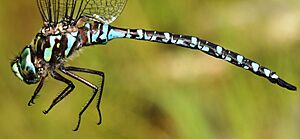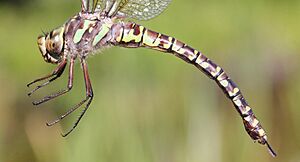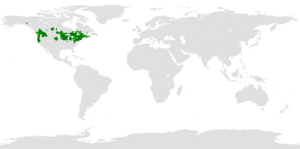Canada darner facts for kids
Quick facts for kids Canada darner |
|
|---|---|
 |
|
 |
|
| Male (top) and female (bottom) | |
| Conservation status | |
| Scientific classification | |
 |
|
| Range of Aeshna canadensis |
The Canada darner (scientific name: Aeshna canadensis) is a type of dragonfly. It belongs to the Aeshnidae family. You can often find these dragonflies in southern Canada and the northern United States.
Contents
What Does the Canada Darner Look Like?
Canada darners are big, slim dragonflies. They are mostly dark brown. They have lighter blue or green patterns on their bodies. Adult Canada darners are usually about 64 to 73 millimeters (2.5 to 2.9 inches) long.
Body Markings
Their middle body part, called the thorax, has two stripes on each side. The front stripe has a special notch and a small extension at the top. Their tail part, called the abdomen, has spots on most of its sections.
Colors
Male Canada darners usually have blue markings. Females can have yellow-green to blue markings. The eyes of males are bluish. Females can have yellowish or bluish eyes. When it gets colder, their light markings might turn gray.
Similar Dragonflies
The green-striped darner looks very much like the Canada darner. But it usually has green stripes on its thorax. The lake darner is also similar. However, it is bigger and has a clear dark stripe across its face.
How Was the Canada Darner Discovered?
The Canada darner was first officially described in 1908. A Canadian entomologist (someone who studies insects) named Edmund Murton Walker described it. He also described several other darner species at the same time.
Where Do Canada Darners Live?
Canada darners live across a wide area. You can find them from Newfoundland and New Jersey in the east. They live all the way to Yukon in the west. They also live south along the Appalachian mountains to West Virginia. Some populations are found in mountain ranges as far as California and Montana. There is even a small group living in Nebraska.
What is the Life of a Canada Darner Like?
Canada darners spend most of their lives as nymphs. Nymphs are the young, underwater stage of the dragonfly. They live in lakes and ponds. They especially like bog ponds and beaver ponds. These ponds usually have lots of plants growing out of the water.
Nymph Life
One study found that Canada darner nymphs might stay underwater for one or two winters. After this time, they change into adult dragonflies.
Adult Life
Adult male Canada darners fly slowly along the edges of ponds. They are looking for females. Mating happens in nearby bushes. Females lay their eggs at the water's surface. They usually lay them in marshy plants away from the shore. Adult dragonflies are most active when the weather is sunny.
Away from their breeding spots, adult Canada darners often fly with other darner species. They form feeding swarms in open areas and along roads. This usually happens in the early evening. You can see adult Canada darners flying from June to October.
Canada darners are often seen as a common species. Most people don't think they migrate. However, a study in Manitoba and Minnesota found that some Canada darners do travel north and south within their home range.
Images for kids





